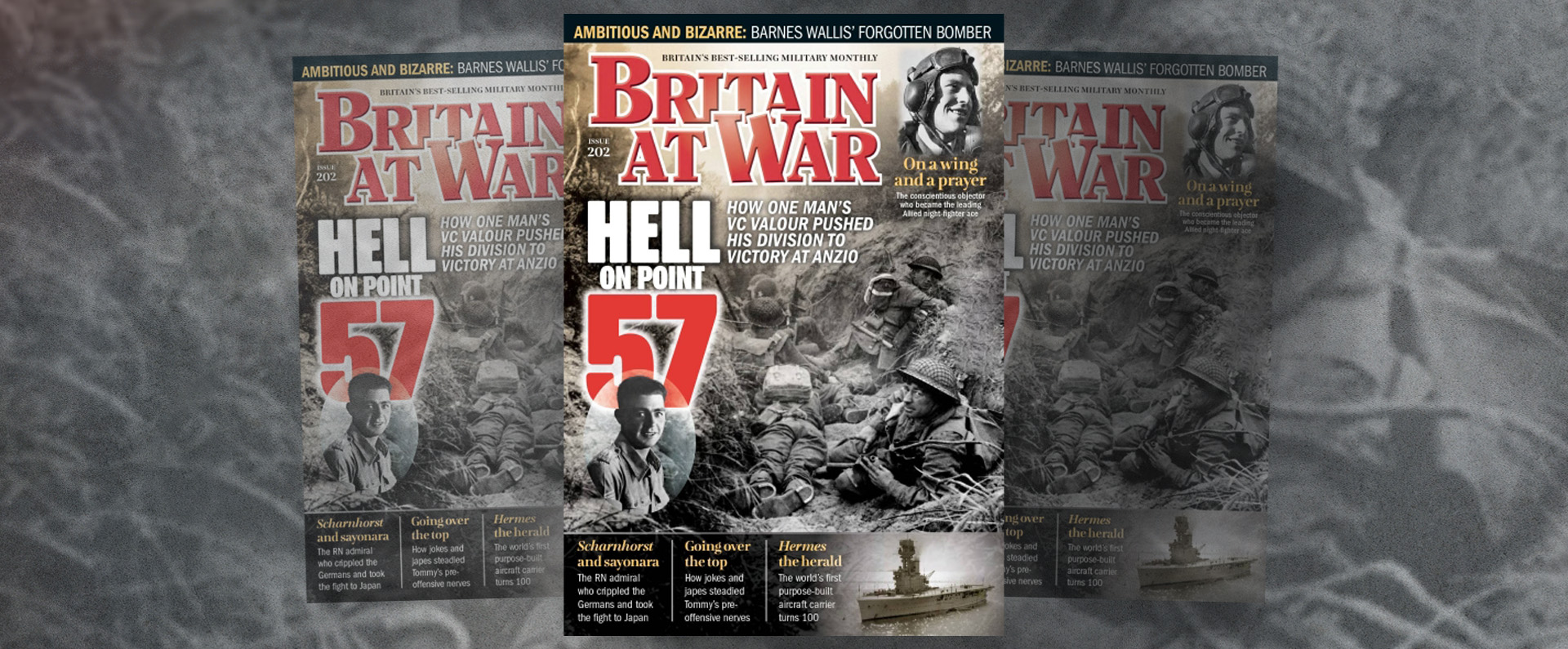
Published in The Mail on Sunday on 01 March 2020.
Man-eating sharks on the prowl in the Channel… German sailors incinerated when we set the sea on fire… Propaganda radio station that wooed the Nazis with porn…
It was Sir Winston Churchill who said: ‘In wartime, truth is so precious that she should always be attended by a bodyguard of lies.’ For the last four years of the Second World War, the role of bodyguard was played – in part at least – by a highly secretive government department called the Political Warfare Executive.
While it was left to our Armed Forces to defeat Hitler on land, at sea and in the air, the least known of the UK’s nine wartime secret intelligence organisations conducted an unrelenting psychological campaign against the Nazis.
Last month, I was given exclusive access to the PWE’s former home in Bedfordshire as part of my attempt to shed more light on a fascinating story of misinformation and intrigue, which even today receives all too little attention.
President Donald Trump and others talk about ‘fake news’ as if it were invented in an age of social media. But my response is that they must have little or no knowledge of some spectacular wartime deceptions, notably those devised at the headquarters of the PWE, a two-storey red-brick building in the rambling grounds of Woburn Abbey, the ancestral home of the Dukes of Bedford.
It was there that a special team of operatives dreamed up a series of wild and wonderful tales designed to destabilise the German war effort – including rumours that the British government had imported 200 man-eating sharks from Australia and that they had been released into the English Channel to eat Germans.
Political deception is as old as politics itself. After the Battle of Kadesh in 1274 BC (in modern-day Syria), Ramesses the Great spread lies to the effect that the largest chariot battle ever fought had been a great victory for the Egyptians over the Hittite Empire. In truth, the result had been a stalemate followed by a peace treaty.
Yet nothing – not even the propaganda efforts of the Great War – came close to the sort of highly organised, long-term government campaigns that would emerge in the course of the Second World War.
The origins of the PWE lay in the Munich Agreement of September 30, 1938, after which Neville Chamberlain famously claimed to have brought back ‘peace with honour’, only to find that he had been deceived by Hitler.
Propaganda was in its infancy. Britain, for example, was relying on a plan to bombard Germany with tens of millions of anti-Hitler leaflets dropped by RAF aircraft and small balloons. With war seeming ever more likely, Sir Stephen Tallents, the director general designate of the Ministry of Information (MoI), called for ‘properly co-ordinated arrangements for the conveyance of information to enemy countries’ with, in particular, the aim of spreading ‘black’ or subversive propaganda. But it was not until August 1941, with France now occupied, that the PWE was officially formed.
The aim was not just to spread anti-Nazi sentiment, but to circulate information that ranged from exaggeration to outright lies.
Bruce Lockhart, who was appointed director general in 1942, described the executive’s role thus: ‘To undermine and destroy the morale of the enemy and… to sustain and foster the spirit of resistance in enemy-occupied countries.’
Radio broadcasts, the cheapest and most accessible form of entertainment and information, soon emerged as the most powerful weapon in the PWE armoury.
The executive ran 48 secret radio stations, including five in Occupied France. Secret transmitters were hidden in Germany.
The tentacles of the PWE stretched far and wide as it tried to influence public opinion in the Low Countries, the Balkans, Yugoslavia, Greece, Scandinavia, Eastern Europe, Middle East, North Africa, India and elsewhere.
Its resources were formidable, with more than 500 staff, many of them working on the Woburn Abbey estate, and with a smaller number based in Central London.
The broadcast operation was set up and overseen by Sefton Delmer, a British journalist who had lived in Berlin as a boy and spoke perfect German. Delmer had friends in the Nazi Party, although he abhorred their views, and he was the first British journalist to interview Hitler. Propaganda from a newly created radio station called Gustav Siegfried Eins (popularly known as GS1) included stereotyping Nazi Party officials as selfish, corrupt and sexually depraved gangsters whose behaviour contrasted with ‘the devotion to duty shown by our brave troops freezing to death in Russia’. Masquerading as a ‘pirate’ German station, GS1 made efforts to appear patriotic, peppering its coverage with disparaging references to Churchill, describing him, for example, as ‘the flat-footed son of a drunken Jew’.
To get Germans civilians to listen in the first place, GS1 had resorted to broadcasting erotic and sometimes blatantly pornographic material amid the fake news.
The BBC’s French Service continued with its own programme of propaganda, broadcasting seven news bulletins a day to Occupied and Vichy France (the southern half of the country, which was under a puppet government controlled by Marshal Petain).
But the PWE also created Radio Inconnue, which specialised in attacking Petain and advocated measures from passive resistance to slashing German tyres and even to murdering traitors. These and other French shortwave broadcasts purported to be live, but most, in fact, were prerecorded.
Similar stations were set up in Italy, including Radio Italia and Radio Liberta, which mounted vicious attacks on Mussolini’s private life, including the false allegation that he had married his half-sister, and compared him to the tyrannical Roman Emperor Caligula. Together with its American counterpart, the Office of War Information (OW I), the PWE broadcast hundreds of thousands of hours of propaganda and dropped an incredible 265 million anti-Nazi leaflets on Germany over four years. With the help of the Special Operations Executive (SO E), a fore- runner of MI6, the PWE also sent agents to occupied countries, where they leaked forged documents and spread false rumours.
Hoping, for example, to deter the planned enemy invasion, the PWE promoted the wild rumour that the British military had invented a means of setting the sea on fire. The lie took hold and soon it was being claimed that hospitals were filled with German soldiers and sailors suffering from terrible burns, and that trainloads of incinerated German corpses had been taken away from the coast.
It was also claimed that the Eiffel Tower was going to be dismantled by the Germans so that the metal could be used for munitions.
From 1942 onwards, the executive came under the joint control of the Foreign Office and the Ministry of Information.
The early propaganda efforts were targeted at civilians to convince them that Germany’s defeat was inevitable but, as the war progressed, the PWE turned to German soldiers, too.
Research carried out among prisoners of war showed steadily declining morale.
In 1940 and 1941, virtually every German soldier thought victory was just around the corner. By the beginning of 1943, 30 per cent of German soldiers had complete confidence in a German victory – but by the end of the year, after the fall of Stalingrad, this number had fallen to just eight per cent.
Later, the PWE would be presented with a more sophisticated task: to somehow persuade the German population that its defeat would not necessarily be disastrous and that, although the Nazi Party leaders and war criminals would be punished, there was room for a new, reconstituted Germany in a peaceful Europe.
In Italy, the initial aims were to show that the war would be long and difficult, to blame Mussolini for the hardships of ordinary Italians, and to make it clear that Britain distinguished between the Fascists and the Italian people. The PWE also put it about that the Germans hated Italians. After the fall of Mussolini in mid-1943, the aims changed: now the PWE wanted to show that Italian defeat was inevitable, that it was in the interests of the Italians to shorten the war, and that they could do so without dishonour.
So successful was the PWE at spreading fake news that Sefton Delmer was named in the Sonderfahndungsliste GB, the so-called black book, which listed those who should be arrested after a German invasion of Britain.
After the war, David Garnett, the executive’s director of training, drew up confidential conclusions and recommendations based on the PWE’s work. Initially distributed to a highly restricted audience in February 1947, the documents were made public only in 2002. Garnett’s key conclusion was: ‘I am convinced that Political Warfare will play a larger part in the future, both in peace and war. The increase of popular education, the development of wireless broadcasts and television, of advertising and the study of mass psychology, make it probable that the psychological pressures of various kinds will be increasingly applied by one country to another.’
And how right he was. Even in 1947, Garnett had noted that the ‘USA and USS R are committed to political warfare’ and today, more than seven decades on, foreign powers are trying to influence everything from public opinion to election results in other countries.
In theory, the BBC and the PWE had worked together but, with different agendas, the two organisation were often at loggerheads.
Another of Garnett’s recommendations was as controversial then as it would be now: ‘During war, the department [PWE] should be given executive and administrative powers over BBC services directed to enemy-controlled countries.
‘The name BBC should be retained for purposes of goodwill, and as cover, but the BBC staff should become PWE staff, should be paid by PWE and have no right to appeal to the Governors of the Ministry of Information.’
BBC bosses, who during and after the war prided themselves on the accuracy of their news coverage, were hugely reluctant to be used as a weapon of war and misinformation, but the matter was never settled.
Today, the former PWE building at Woburn Abbey is dilapidated. Doors are missing, windows are broken, the paint is peeling.
But moves are afoot to turn the site into a new Military Intelligence Museum. It will need a public fund-raising campaign, but if all goes to plan, this would be the foremost museum of its kind in the world – and in a fitting location.
As for the future, my own conclusion is that in an age of social media, the influence of fake news will only grow. As the American writer Mark Twain once put it: ‘A lie can travel around the world and back again while the truth is putting its boots on.’
Read this article on the DailyMail.co.uk
For more information, visit:
LordAshcroftOnBravery.com


